 Go
to the Archive index
Go
to the Archive index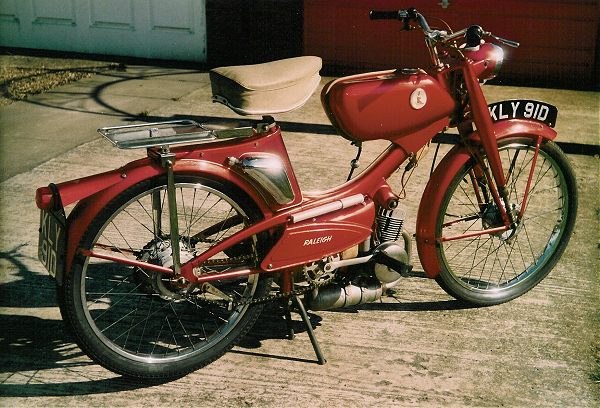
The Raleigh RM11 Super Tourist
June 1965, and Raleigh extends its range of moped models with the announcement of the RM12 Super 50. This is a unique sports variant based on the RM6 Runabout rigid frame, but equipped with the 2.7bhp AV89 variator motor by means of special melatastic engine mountings welded to the frame. The installation was so unique that Motobécane never even issued their own version of this combination, favouring derivatives of the fully sprung frame for their Sports Spéciale models. So, at £87-19-6d, the Super 50 gave Raleigh a unique sports moped, at an appreciably lower cost than Motobécane's Spéciale. While the frame, forks, engine and flywheel came from Motobécane, much of the rest of the bike was built-up by Raleigh. The Atom hubs were laced into Dunlop Endrick rims, frame trim and toolboxes recycled from the now obsolete RM4, the new sports petrol tank was Raleigh's own product, and was matched with a dual seat. Now maybe you're thinking this article is going to be on the RM12, but we don't want to give you that!
At this time, models up to and including the RM4 had become obsolete. In production were the RM5 Supermatic, RM6 Runabout, RM8 Runabout (teleforks), RM9 Ultramatic, and RM12. There are notably a few numerical gaps in the Raleigh series for pre-planned models not yet introduced, RM7 being the designation held over for the Wisp, RM10 became the dual-seat Runabout RM9+1, and the mysterious subject of today's item the rare and elusive Raleigh RM11.
"Day Tripper" by The Beatles topped the pop charts, and the "Super Tourist" was announced on 1st January 1966 as a touring version of the RM12, and it has a number of different features to characterise it. The handlebars are mounted in the customary position, not dropped like the RM12. Instead of Raleigh's own "Super-comfort" saddle, the Denfeld single-seat is a rather unexpected fitting, behind which mounts a special chrome rack dedicated to the model. Paintwork is finished in magnificent Royal Carmine Red. The RM11 marries a conventional riding position with the powerful 2.7bhp AV89 motor, and the lightness of the Runabout frame (a mere 102lbs, while the RM5 weighed in at 112lbs). Once all the comparative drive ratio calculations are worked out between the two machines, the RM11 appears to be geared 2% higher than the RM5, so we should be looking at a fair performer here! Raleigh's sales brochure posted the list price at £79-19-6d, quite reasonable considering its sporting specification!
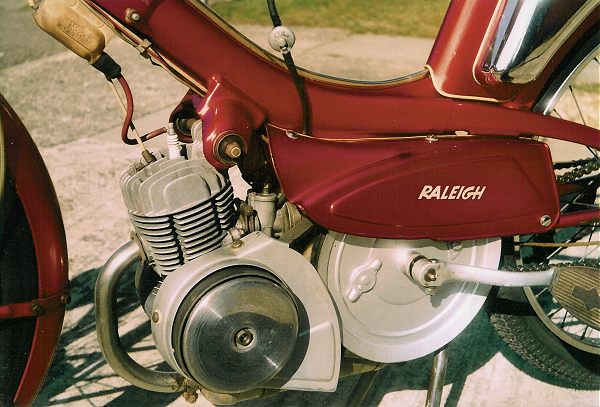
The RM11's 2.7 bhp AV89 engine
Ah, now, on the subject of looks it's probably fair to say that styling of the RM11 is, well... interesting! It seems to prompt different reactions from different people. Unusual? Certainly unique! Pretty? Or maybe just an assembly of components from the odd parts bin, that were never really meant to fit together? Perhaps it'll look better with a rider on board so, we've brought back our popular Raleigh supermodel Rhoda, to see if she can improve it!
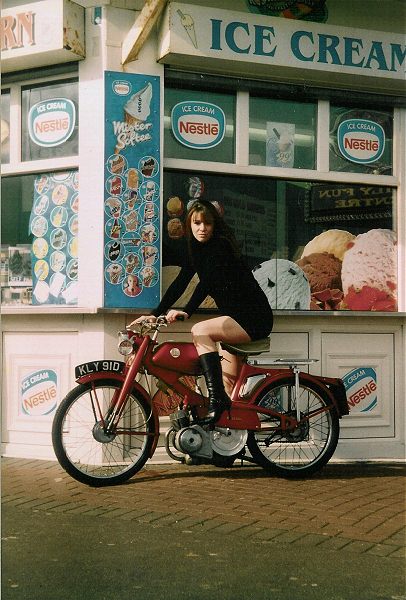
There, looks better already doesn't it?
Starting the RM11 isn't as easy as the more usual kick-starting style method on the stand beside the bike. Somehow it offers a lot of resistance from the pedal ratio and engine compression, and requires rather too much effort to start on the stand, much better to pedal it away down the road. The motor fires up readily enough, then keep flicking at the choke trigger until it's not required anymore. The bike easily pulls up to a comfortable indicated 30mph cruising speed, and after coasting along for a while to warm-up the engine, it's some surprise to wind open the twistgrip and find there's quite a considerable rotation to go! It seems to do the town speed limit with very minimal effort! The motor delivers a convincingly strong urge in response to the throttle, but we never really had the opportunity of conditions to get the Super Tourist up to the screaming revs that AV89s are typically noted for. Our best paced speed was 40mph down a shallow hill, since strong gusting crosswinds made it all too twitchy to produce any good fast runs; there was certainly more in reserve. Period factory literature listed 45mph available with the rider sitting upright, which would seem quite likely under more favourable conditions. It was further remarkable to note that this particular Huret speedo gave fairly close readings to the pace bike, so some of these wretched instruments do work properly! The Tourist was certainly labouring hard into strong winds on the test day, and felt rather like it was somewhat overgeared for these conditions. The cycle frame rode well on smooth surfaces, but the rigid tail soon got twitchy on bumps, while you really feel the effects of any gusting winds on the light chassis. The full width alloy hub Atom brakes looked good, and delivered excellent stopping from both ends. Lights are 3W rear and 6V × 15W single filament Luxor headlamp up front. Though not really good enough to permit safe use of the bike's full potential at night, this does allow practical illuminated riding up to 30mph bathing the road ahead in a comforting yellow glow!
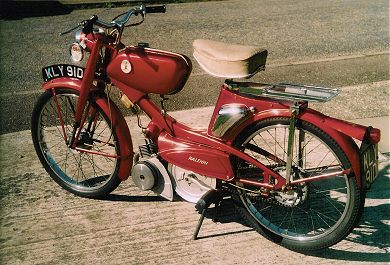
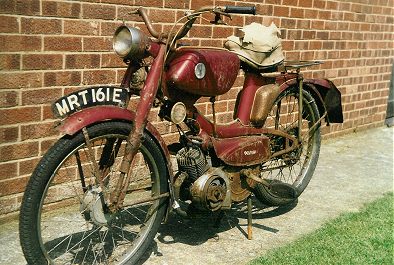
The frame numbers of these two machines are only 162 apart
Examples of the RM11 are very rarely seem, and make interesting study in the close grouping of their chassis serialisations. Our superb test machine with frame number 11R/60017 and registered 23rd June 1966, can be compared against another surviving (though decrepit) specimen, frame number 11R/60179 registered 13th February 1967. The handlebar arrangement between the two examples has changed from a stem mounting set on the earlier test machine, to clamp bolt fixings on the fork yoke for the later model. Despite there being 8 months between the registration dates of these respective machines, there is only 162 frame units difference between the serial numbers. If this could be taken as some indication of how many RM11s were actually made, projection of these figures over the production period may suggest only some 400 machines produced!
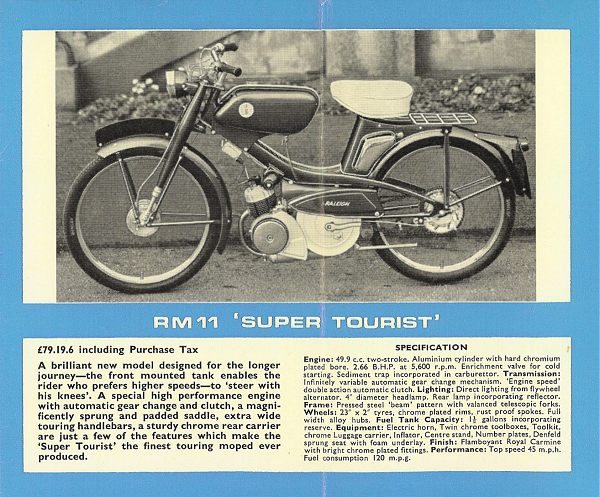
Original Publicity
Even the NACC records are very scant for examples of this model, and fail to provide any further useful frame reference data.
The gutsy AV89 motor was probably a bit much for the frail bottom engine bracket, which invariably seems responsible for a misaligned belt run. 9:1 compression ratio, 14mm Gurtner carb and 2.7bhp tearing away at the mountings invariably proved more than the flimsy commuter frame could stand for long. Even if you just dropped the bike it could set the belt run out of critical alignment, resulting in scraping noises, vibration, and dead belts. Motobécane themselves never produced a model with the AV89 motor in their basic commuter chassis, perhaps they felt it wasn't really suitable perhaps they were right?
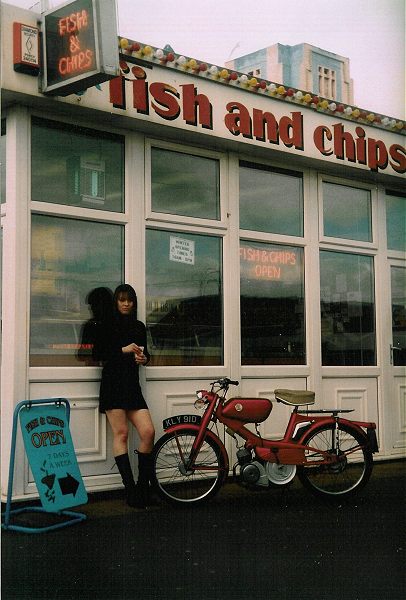
It was difficult to figure what the RM11 was intended to be. A hybrid between a sports and a commuter moped? Maybe Raleigh hoped to create a whole new fashionable class of machine, but the buying public largely passed it by, and sales were pretty dismal. Looks? Cost? Frailty? Whatever the reason, as Procol Harum sat at the top of the singles charts with "A Whiter Shade of Pale", a discontinuance note was served in July1967. Listed for a mere 18 months, the Super Tourist was deleted, and unjustifiable as a stand-alone model the Super 50 went down with it.
Next: 1931, House of Commons, Westminster. Philip Snowden, Chancellor of the Exchequer, rises from his seat, opens his briefcase, and produces a pile of papers, which he stacks on the lectern. Nearly two hours into his droning budget speech, and among the trivial details, he mentions the introduction of a new tax concession for machines under 100cc. We return to Old London for a classic tale of mechanical horror!
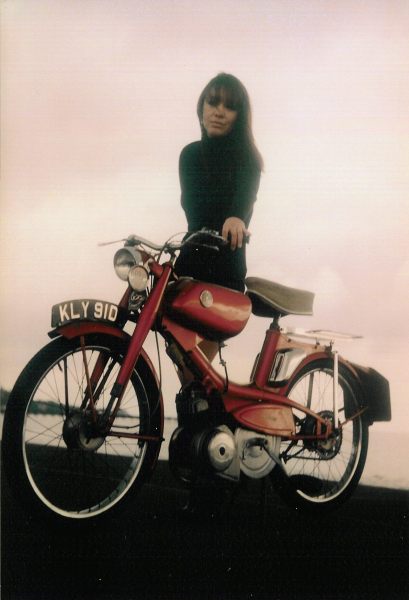
First published, April 2005